Top Rankings
Dothan City School District ranks among the top 20% of public school district in Alabama for:
Category
Attribute
Community Size
Largest student body (number of students) (Top 1%)
For the 2025 school year, there is 1 public preschool serving 208 students in Dothan City School District.
Public Preschools in Dothan City School District have a diversity score of 0.64, which is more than the Alabama public preschool average of 0.63.
Minority enrollment is 70% of the student body (majority Black), which is more than the Alabama public preschool average of 48% (majority Black).
Overview
This School District
This State (AL)
# Schools
18 Schools
648 Schools
# Students
8,035 Students
310,670 Students
# Teachers
471 Teachers
18,546 Teachers
Student : Teacher Ratio
17:1
17:1
District Rank
Dothan City School District, which is ranked within the bottom 50% of all 145 school districts in Alabama (based off of combined math and reading proficiency testing data) for the 2021-2022 school year.
The school district's graduation rate of 90% has increased from 89% over five school years.
Overall District Rank
#94 out of 145 school districts
(Bottom 50%)
(Bottom 50%)

Math Test Scores (% Proficient)
19%
29%
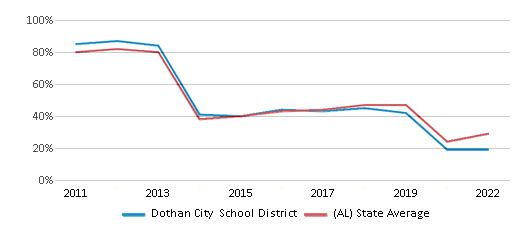
Reading/Language Arts Test Scores (% Proficient)
40%
47%
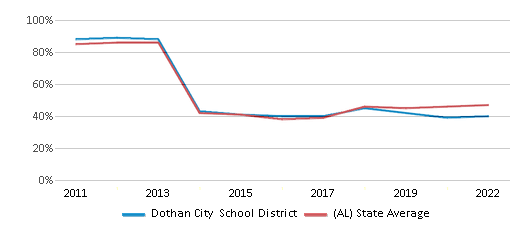
Science Test Scores (% Proficient)
29%
38%

Graduation Rate
90%
88%
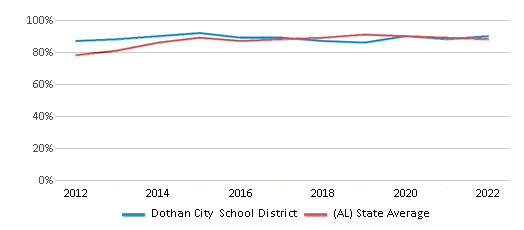
Students by Ethnicity:
Diversity Score
0.57
0.63
# American Indian Students
13 Students
3,275 Students
% American Indian Students
n/a
1%
# Asian Students
165 Students
3,474 Students
% Asian Students
2%
1%
# Hispanic Students
705 Students
33,026 Students
% Hispanic Students
9%
11%
# Black Students
4,800 Students
93,822 Students
% Black Students
60%
30%
# White Students
2,111 Students
162,634 Students
% White Students
26%
52%
# Hawaiian Students
6 Students
315 Students
% Hawaiian Students
n/a
n/a
# Two or more races Students
235 Students
14,124 Students
% of Two or more races Students
3%
5%
Students by Grade:
# Students in PK Grade:
208
21,304
# Students in K Grade:
675
49,720
# Students in 1st Grade:
715
50,373
# Students in 2nd Grade:
682
48,594
# Students in 3rd Grade:
619
40,410
# Students in 4th Grade:
612
36,751
# Students in 5th Grade:
607
31,378
# Students in 6th Grade:
579
12,553
# Students in 7th Grade:
545
4,421
# Students in 8th Grade:
577
4,401
# Students in 9th Grade:
619
2,950
# Students in 10th Grade:
601
2,768
# Students in 11th Grade:
542
2,555
# Students in 12th Grade:
454
2,492
# Ungraded Students:
-
-
District Revenue and Spending
The revenue/student of $13,388 is higher than the state median of $13,006. The school district revenue/student has stayed relatively flat over four school years.
The school district's spending/student of $13,363 is higher than the state median of $12,220. The school district spending/student has stayed relatively flat over four school years.
Total Revenue
$108 MM
$9,671 MM
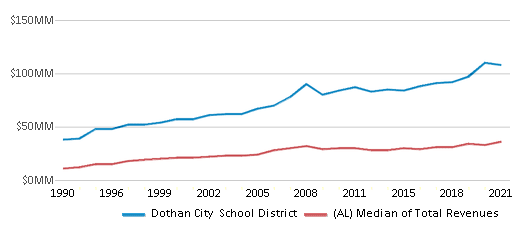
Spending
$107 MM
$9,086 MM
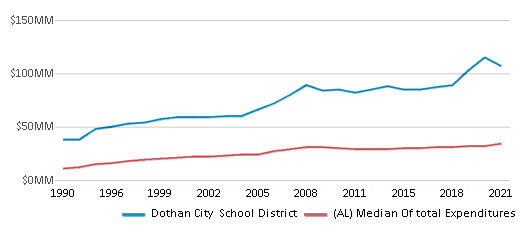
Revenue / Student
$13,388
$13,006
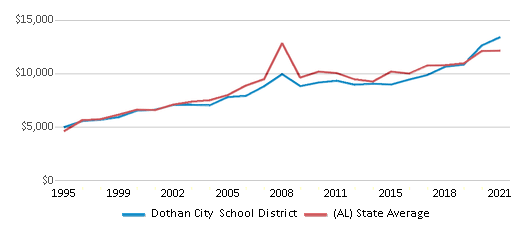
Spending / Student
$13,363
$12,220
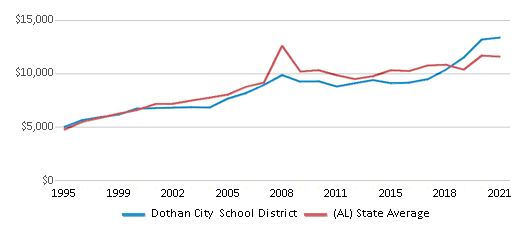
Best Dothan City School District Public Preschools (2025)
School
(Math and Reading Proficiency)
(Math and Reading Proficiency)
Location
Grades
Students
Rank: n/an/a
1665 Honeysuckle Road
Dothan, AL 36301
(334) 794-1420
Dothan, AL 36301
(334) 794-1420
Grades: PK
| 208 students
Recent Articles

What Is A Charter School?
Explore the world of charter schools in this comprehensive guide. Learn about their history, how they operate, and the pros and cons of this educational innovation. Discover key facts about charter schools, including admission policies, demographics, and funding, as well as what to look for when considering a charter school for your child.

10 Reasons Why High School Sports Benefit Students
Discover the 10 compelling reasons why high school sports are beneficial for students. This comprehensive article explores how athletics enhance academic performance, foster personal growth, and develop crucial life skills. From improved fitness and time management to leadership development and community representation, learn why participating in high school sports can be a game-changer for students' overall success and well-being.

February 05, 2025
Understanding the U.S. Department of Education: Structure, Impact, and EvolutionWe explore how the Department of Education shapes American education, from its cabinet-level leadership to its impact on millions of students, written for general audiences seeking clarity on this vital institution.





